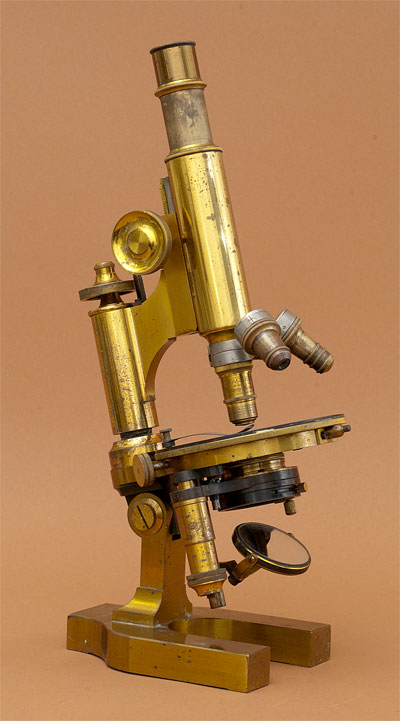Results of Golub Collection search: Microscope No. 318
Alfred Nachet Continental Microscope Model No. 5 (No. 318)
Made: c1900
Made by: Alfred Nachet
Made in: France
Although Nachet was undeniably one of the most important 19th continental microscope manufactures – surprisingly enough – Nachet never manufactured the classical continental stand. The ‘standard’ horse-shoe based model was introduced by Oberhaeuser, and slightly further developed by his successors, Hartnack, Prazmowski and eventually Bezu & Hausser. When the German manufacturers (Zeiss, Leitz) finally started to penetrate the microscope market in the 1880s, they did so by flooding the market with horse-shoe base models copied from Hartnack.
While Nachet’s large microscopes did follow the general layout of Oberhaeuser’s horse-shoe base microscope, they were far more elaborate and elegant. It is therefore that Nachet was regarded as the “most English” microscope manufacturer on the continent. In 1883, the severely ill Adam Prazmowski offered his company to his competitor Alfred Nachet. From the 1850s to the 1870s, the companies of Nachet and Oberhaeuser & Hartnack had monopolized the continental market. The 1883 takeover failed, but in July 1896 Alfred Nachet finally got his hands on the the former company of Oberhaeuser & Hartnack, purchasing it from Bézu & Hausser. As a consequence of the takeover, the 1898 Nachet catalogue for the first time featured the continental stand. By finally including the standard continental stand in its range as late as 1898, Nachet was the last continental manufacturer to adopt it. Even the English manufacturers Ross and Beck had – reluctantly – were earlier to adopt the continental stand! As if feeling the need to apology for including the continental stand microscope in its 1898 catalogue, Nachet announced it at follows: “Nous construisons ce modèle depuis que nous avons réuni à nos ateliers ceux de la maison Bézu, Hausser & Cie (anciennement Hartnack et Prazmowski). [voir page 11].” English translation: “We manufacture this model since we joined to our workshops those of Bézu, Hausser & Cie (formerly Hartnack and Prazmowski). [see page 11].”
This instrument was presented as the last large model microscope: N° 5. Nachet described its merits – or more precisely its sole merit – as follows: “Le n°5 à platine tournante à centrage, que nous construisons depuis que nous avons réuni à notre maison celle de MM. Bézu, Hausser et Cie (anciennement Hartnack et Prazmowski), est un perfectionnement de l’ancien modèle d’Oberhaeuser et d’Hartnack qui, jusqu’à présent, a servi presque exclusivement de type aux constructeurs continentaux”. English translation: “The n° 5 with rotating and centering stage, which we manufacture since we joined to our company that of Mr. Bézu, Hausser and Co. (formerly Hartnack and Prazmowski), is an improvement of the old model of Oberhaeuser and Hartnack which, until now, has served almost exclusively as a model to the continental makers.” The standard continental model was featured in the 1898, 1900 and 1904 Nachet catalogues, but had already disappeared in the 1910 catalogue.
This microscope can be considered as a meeting point between two different branches of 19th century French microscope manufacture. On the one hand, there is the branch founded by Vincent & Charles Chevalier, of which Camille and Alfred Nachet were the true successors. (Charles Chevalier son, Arthur, died in 1874 without a true successor.) On the other hand, the was the ‘German’ – more rational – branch founded by Georges Oberhaeuser, succeeded by Edmund Hartnack, Adam Prazmowski, Bézu & Hausser. (With the Vérick-Stiassnie firm as one of the side branches.) In this the microscope of the continental form the two branches finally came together – albeit reluctantly.
Unsurprisingly, few examples of this continental model made by Nachet are known.
The microscope has some traces of use and spots, but preserved a large part of its original lacquer. It is in perfect mechanical condition. Optics consist of one Nachet eyepiece numbered 1, two Nachet objectives numbered 7 and 1/12 immersion, and two Zeiss objectives numbered AA and DD. It has a substage Abbe condenser plus iris. Focus is typicallyR&P plus a short-arm fine focus. The microscope is preserved in its original mahogany case, which is a typical Nachet product, contrary to the microscope itself.
Text by Alexander Piffault, La Zograscope, Paris.
Featured 12/2018

